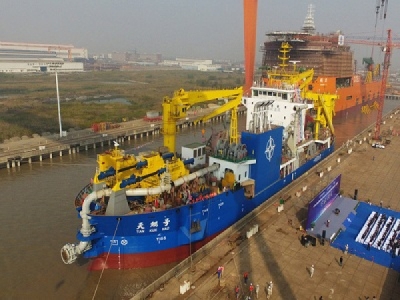
Posted on December 28, 2017
By Audrey Morallo, American Shipper
China intends to use its “magical island maker” to expand the size of its reclaimed islands in the South China Sea following years of massive reclamations and despite continuing protests from neighboring countries.
“The size of some South China Sea Islands will be further expanded in the future with more dredging vessels, such as the [Tian Kun Hao] working on the land reclamation projects in the South China Sea region,” Chen Xiangmiao, a research fellow at the National Institute for the South China Sea, the state-run Global Times said.
Chen said that one of the most outstanding achievements of China’s island-building in the contested waters was the increase in civilian facilities on these man-made features, thereby improving public service capacity and helping maintain sovereignty over them.
This expansion will likely continue just months after China in November launched Tian Kun Hao, its biggest island-making vessel and described as a “magic island maker.”
A new government report said that China “reasonably” expanded the area of its South China Sea islands, with construction projects in 2017 alone covering about 290,000 square meters.
The report was released on nanhai.haiwainet.cn, a website run by the National Marine Data and Information Service and the ruling Communist Party’s People’s Daily overseas edition. It appeared in the Global Times on December 24.
These construction projects, according to the report, included new underground facilities for storage, administrative buildings and a large radar.
It said that the construction activities will help China meet its “international responsibility” including maritime search and rescue and navigation safety and environment protection.
They can also help Beijing enhance its military defense capability within its “sovereign scope,” with more Chinese troops being stationed in the area, a move likely to further worry its neighbors and the US.
The Chinese report generally reinforced a warning by an American think tank which provided satellite imagery showing China’s unceasing construction activities on its artificially-made features in the disputed waters.
The report by the Asia Maritime Transparency Initiative concluded that Beijing “remains committed” to moving to the next phase of its activities such as construction of facilities needed for fully-functioning air and naval bases.
However, despite this relentless construction work, the Philippines seemed unalarmed.
Manila said Monday that despite China’s admission that it expanded its islands in the contested waters it would continue to rely on Beijing’s “good faith.”
Harry Roque, a spokesman for President Rodrigo Duterte, stressed that the Philippines needed to first ascertain the areas where the construction activities took place.
“Location is material since we do not have claims on all the islands and waters in the disputed area,” Roque said in a text message to reporters.
Earlier this month, Alan Cayetano, the Philippine foreign secretary, downplayed AMTI’s report and defended that China had not occupied new features in the contested waters.
This largely echoed his statement during a regional meeting of foreign ministers in Manila in August when he revealed that he pushed for the removal of a mention of Chinese reclamation activities in the waters in a chairman’s statement he was about to issue.
The Philippines and China have experienced warmer ties under President Rodrigo Duterte who wants to entice Chinese money to invest in the developing country’s economy and infrastructure market.
This relationship is a marked improvement of the frosty ties during the administration of former President Benigno Aquino III who brought China to a United Nations-backed tribunal following a naval standoff between the two nations years ago.
The tribunal ruled in Manila’s favor last year and invalidated China’s expansive claims in the region.
Aside from the Philippines and China, Brunei, Malaysia, Taiwan and Vietnam also have rival claims over the waters through which $5 trillion worth of annual trade passes.
Source: American Shipper





